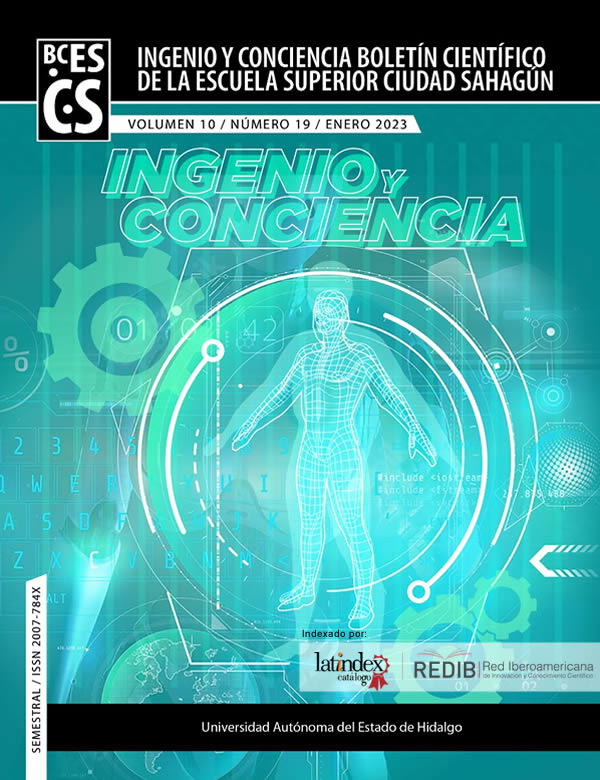Programación de propiedades aplicadas a sistemas de refrigeración por absorción
DOI:
https://doi.org/10.29057/escs.v10i19.9693Palabras clave:
Propiedades, programación, ESS, ARS, COP, interpolación multipleResumen
El objetivo de este trabajo es desarrollar un modelo computacional que ayude a predecir las propiedades termodinámicas de la mezcla CaCl2-LiBr-LiNO3-H2O, las cuales sean utilizadas para el análisis y simulación de sistemas de refrigeración por absorción. El estudio está basado en la metodología de interpolación múltiple desarrollada en el software Engineering Equation Solver (EES) y los valores obtenidos son comparados con aquellos obtenidos experimentalmente. Los resultados muestran que el modelo desarrollado predice adecuadamente las propiedades de presión de vapor, entalpía específica y calor específico y los máximos porcentajes de desviación obtenidos son de 9.34%, 0.027% y 0.15%, respectivamente. Además, los resultados de la simulación muestran que, para las mismas condiciones de operación, se obtiene un error del COP del 4.58% cuando el sistema opera a una efectividad de 1.0 (100% de su capacidad), mientras que el menor error del COP del 1.02% se obtiene a una efectividad del 0.6 (60% de su capacidad), en comparación con los resultados presentados en la literatura.
Descargas
Información de Publicación
Perfiles de revisores N/D
Declaraciones del autor
Indexado en
- Sociedad académica
- N/D
Citas
Ahmad T., Azhar Md., Sinha M.K., Meraj Md., Mohammed Islam., Ahmad A., 2022. Energy analysis of lithium bromide-water and lithium chloride-water based single effect vapour absorption refrigeration system: A comparison study. Cleaner Engineering and Technology, 7, 100432. DOI: 10.1016/j.clet.2022.100432
Chen, D., Xie, J.H., 2006. Heat Pump Water Heater. Chemical Industry Press, Beijing, pp. 201.
Chen Y., Zhou T., Zhao T., He Y., 2022. Thermodynamic analysis of H2O−3-aminopropyl tributyl phosphonium glycinate as a working pair for absorption refrigeration system. Applied Thermal Engineering, 213, 118658. DOI: 10.1016/j.applthermaleng.2022.118658
Du S., Wang R.Z., Lin P., Xu Z.Z., Pan Q.W., Xu S.C., 2012. Experimental studies on an air cooled two stage NH3-H2O solar absorption air-conditioning prototype. Energy, 45, 581-587. DOI: 10.1016/j.energy.2012.07.041
Fernández-Seara J., Vázquez M., 2001. Study and control of the optimal generation temperature in NH3-H2O absorption refrigeration systems. Applied Thermal Engineering, 21, 343-357. DOI: 10.1016/S1359-4311(00)00047-8
Fernández-Seara J., Sieres J., 2006. Ammonia-water absorption refrigeration systems with flooded evaporators. Applied Thermal Engineering, 26, 2236-2246. DOI: 10.1016/j.applthermaleng.2006.03.011
Florides, G.A., Kalogirou, S.A., Tassou, S.A., Wrobe, L.C., 2003. Design and construction of a LiBr-water absorption machine. Energy Conversion and Management 44, 2483–2508. DOI: 10.1016/S0196-8904(03)00006-2
He, Z.B., Zhao, Z.C., Zhang, X.D., Feng, H., 2010. Thermodynamic properties of new heat pump working pairs: 1, 3-dimethylimidazolium dimethyl phosphate and water, ethanol and methanol. Fluid Phase Equilibria 298, 83–91. DOI: 10.1016/j.fluid.2010.07.005
Jawahar C.P., Raja B., Saravanan R., 2010. Thermodynamic studies on NH3-H2O absorption cooling using pinch point approach. International Journal of Refrigeration, 33, 1377-1385. DOI: 10.1016/j.ijrefrig.2010.04.015
Jiang, X., Cao, Z., 2003. A group of simple precise formulations for properties of water and steam. Power Engineering 23, 2777–2780.
Kilic M., Kaynakli O., 2007. Second law-based thermodynamic analysis of water-lithium bromide absorption system. Energy, 32, 1505-1512. DOI: 10.1016/j.energy.2006.09.003
Li N., Luo C., Su Q., 2018. A working pair of CaCl2 –LiBr–LiNO3/H2O and its application in a single-stage solar-driven absorption refrigeration cycle. International Journal of Refrigeration, 86, 1-13. DOI: 10.1016/j.ijrefrig.2017.11.004
Ma W.B., Deng S.M., 1996. Theoretical analysis of low-temperature hot source driven two-stage LiBr/H2O absorption refrigeration system. International Journal of Refrigeration, 19, 141-146. DOI: 10.1016/0140-7007(95)00054-2
Monné C., Alonso S., Palacín F., Guallar J., 2011. Stationary analysis of a solar LiBr-H2O absorption refrigeration system. International Journal of Refrigeration, 34, 518-526. DOI: 10.1016/j.ijrefrig.2010.11.009.
Patel H.A., Patel L.N., Jani D., Christian A., 2016. Energetic analysis of single stage lithium bromide water absorption refrigeration system. Procedia Technology, 23, 488-495. DOI: 10.1016/j.protcy.2016.03.054
Rogdakis E.D., Antonopoulos K.A., 1992. Performance of a low-temperature NH3-H2O absorption-refrigeration system. Energy, 17, 477-484. DOI: 10.1016/0360-5442(92)90083-C
Soliman A. S., Zhu S., Dong J., Cheng P., 2021. Design of an H2O-LiBr absorption system using PCMs and powered by automotive exhaust gas. Applied Thermal engineering, 191, 116881. DOI: 10.1016/j.applthermaleng.2021.116881
Sun D.W., 1998. Comparison of the performances of NH3-H2O, NH3-LiNO3 and NH3-NaSCN absorption refrigeration system. Energy Conversion and Management, 39, 357-368. DOI: 10.1016/S0196-8904(97)00027-7
Wang Y., Lior N., 2011a. Proposal and analysis of a high-efficiency combined desalination and refrigeration system based on the LiBr–H2O absorption cycle—Part 1: System configuration and mathematical model. Energy Conversion and Management, 52, 220-227. DOI: 10.1016/j.enconman.2010.06.071
Wang Y., Lior N., 2011b. Proposal and analysis of a high-efficiency combined desalination and refrigeration system based on the LiBr–H2O absorption cycle—Part 2: Thermal performance analysis and discussions. Energy Conversion and Management, 52, 228-235. DOI: 10.1016/j.enconman.2010.06.064
Yamamoto E., da Silva R., Higa M., 2022. Performance improvements on energy and exergy basic for an ammonia-water absorption refrigeration system in a coffee industry. Sustainable Energy Technologies and Assessments, 52, 102284. DOI: 10.1016/j.seta.2022.102284
Zhou S., Guogeng H., Liang X., Li Y., Pang Q., Cai D., 2022. Comparison of experimental performance of absorption refrigeration cycle using NH3/LiNO3+H2O working fluids with different component proportions. International Journal of Refrigeration, 139, 25-40. DOI: 10.1016/j.ijrefrig.2022.04.01



















